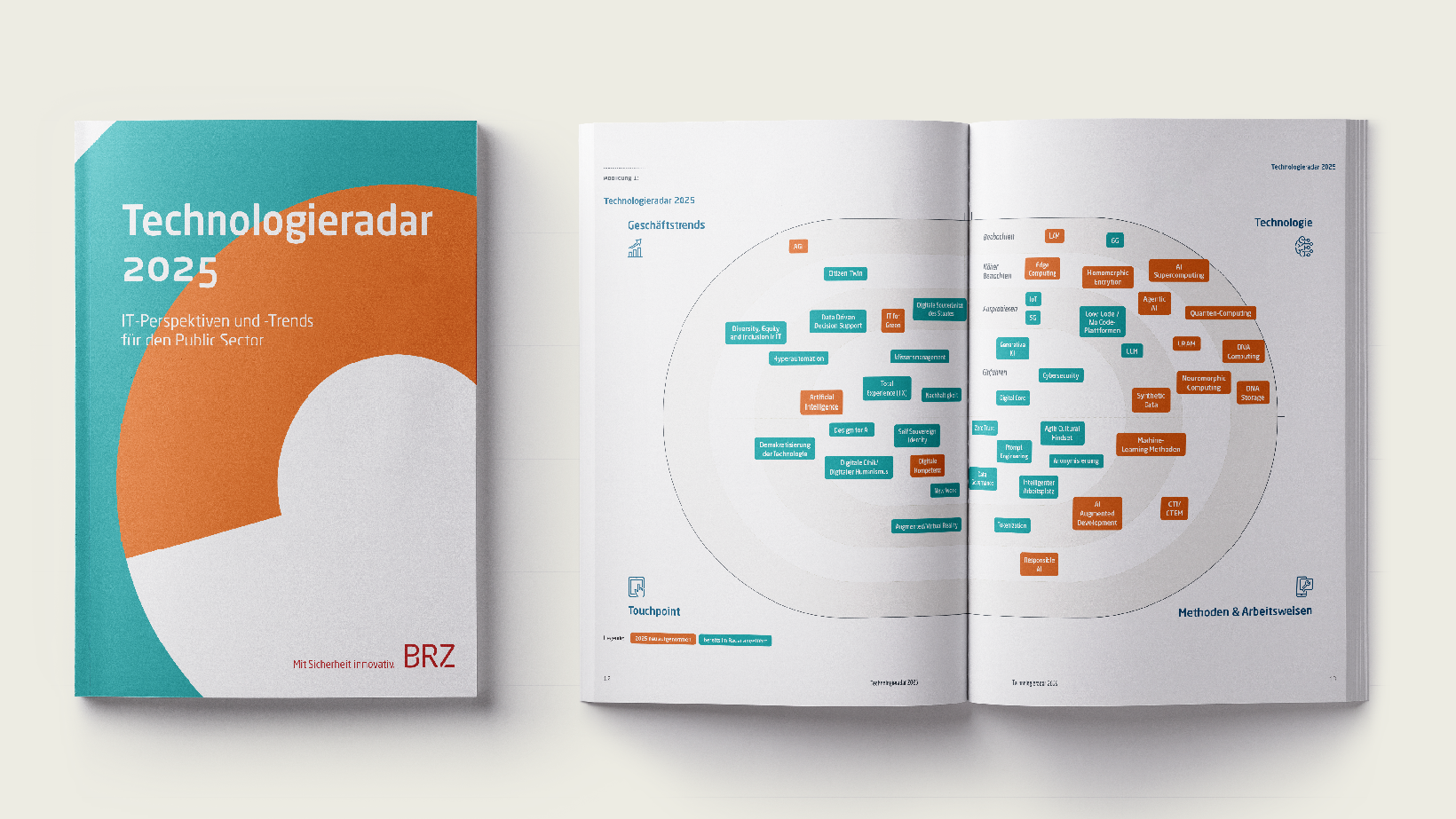
BRZ Technology Radar 2025
09. July 2025
The BRZ is examining 48 technologies in its current Technology Radar; AI is playing an increasingly important role in the development of IT applications.
The Technology Radar, developed by the BRZ, provides an annual report on IT perspectives and trends for the public sector. In 2025, artificial intelligence is continuing to emerge as a leading trend in the development of IT applications for public administration. Significant progress has been made, particularly with the help of generative AI, and concrete applications – such as support services for citizens in their job search – are already available. Trends such as Agentic AI, IT for Green, and Total Experience represent the next step in making AI solutions usable for public sector applications – a domain where requirements for data protection, data security, and digital sovereignty are particularly high. The use of AI in administrative contexts also brings ethical questions to the forefront. Initiatives on digital humanism highlight the importance of placing people at the center of IT development and addressing ethical considerations.
BRZ Managing Director Roland Ledinger
“With the Technology Radar, we have a tool at our disposal that allows us to create transparency and accurately classify the various IT trends and technologies. Artificial intelligence holds great potential for public administration and can be used effectively to address challenges such as the upcoming wave of retirements. We also see significant potential for sustainable cost savings and for supporting the path of consolidation through the targeted use of AI and digitization in general. AI is evolving at a rapid pace, which is why we need to pay close technical attention—especially when it comes to adhering to ethical standards.”
In its Technology Radar, the BRZ has identified six top trends that will shape the IT of public administration in the coming years:
Top Trend 1: Agentic AI
Agentic AI represents the next step in the functionality of AI tools. While traditional chatbots are primarily known for content generation, AI agents will be capable of executing actions and making decisions. Potential use cases include process automation, data analysis, and customer support.
Top Trend 2: IT for Green – AI Brings New Challenges
“Green IT” focuses on making information technology itself more environmentally friendly (e.g., energy-efficient data centers, recycling of IT hardware). In contrast, “IT for Green” centers on how IT can be used to achieve broader ecological goals. The industry as a whole aims to reduce the carbon footprint of IT infrastructure and lower the energy consumption of hardware, software, and data centers. One key challenge is the high energy demand of AI systems and the growing trend toward cloud-based applications.
Top Trend 3: Digital Humanism – Using AI Responsibly
Digital Humanism puts people at the center of technological development. Responsible or trustworthy AI refers to the design and deployment of AI systems with attention to ethical, social, and legal standards. The goal is to ensure that AI systems are transparent, fair, secure, and aligned with values and laws.
Top Trend 4: Synthetic Data – A New Basis for Training AI Models
Synthetic data is artificially generated data used as a substitute for real data across various applications, such as data anonymization, AI and machine learning development, and privacy-compliant data sharing. The time-consuming and costly task of creating test data can be bypassed with synthetic data. A key purpose of synthetic data is to improve AI models in a way that complies with data protection regulations.
Top Trend 5: Total Experience
Total Experience is an approach that combines multiple disciplines, such as user experience (UX) and employee experience. A Total Experience strategy integrates both digital and non-digital technologies to enhance citizen and employee trust and satisfaction with public services, and to enable better personalization. The goal is to allow for tailored communication that addresses the individual needs and expectations of users.
Top Trend 6: Digital Sovereignty
With the increasing digitization of public administration and its services, special attention must be paid to ensuring that the IT products and service providers used do not undermine or gradually erode digital sovereignty (e.g., due to vendor lock-in, legal conditions based on provider or data location, or information security risks). Digital sovereignty is also a key consideration across Europe when it comes to using cloud services in public administration and deploying open-source software.
About the Technology Radar
The BRZ's publication Technology Radar 2025 provides a comprehensive overview of current IT perspectives and trends and their applicability in the public sector. It identifies a total of 48 trends and technologies, 19 of which are new. The Technology Radar supports the identification, selection, and evaluation of technologies and summarizes them in a clear graphical format . It serves as a strategic tool to recognize technological developments early on and to assess the opportunities and risks of technology adoption. In addition to detailed explanations of the trends and technologies analyzed, the publication also features three in-depth chapters that explore current trends in greater detail.

